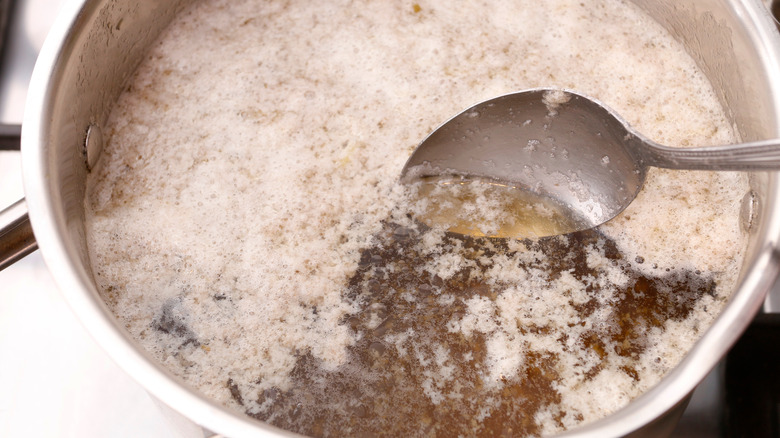The Simple Stock Straining Tip You Need To Know About
Homemade stock is a wonderful thing to have in your fridge or freezer. It adds a depth of flavor to soups, stews, and casseroles that you just can't get from purchased stocks, no matter how expensive they are, per the Chicago Tribune. And it's a great way to reduce waste in the kitchen and use up leftovers. While making stock is easy, there are some tricks to getting clear stock without any extraneous pieces floating in it.
The process of simmering and boiling releases proteins that won't dissolve in water, bits from the veggies as they break down, and any herbs and spices you added, explains Bon Appétit. They create a web of scum on the stock surface and tiny bits floating in it. Clear stock and broth is more appetizing, especially if you're making bone broth. That's why stock must be strained before you can store or use it.
There are many ways to strain stock and broth. You can use a fine mesh sieve or strainer (you might want to splurge and buy a fancy conical strainer called a chinois, according to Recipe Tips), or you can pour the stock through layers of cheesecloth. But who has cheesecloth lying around the house? If you don't have cheesecloth (or a chinois, for that matter) on hand, you can also strain homemade stock with a simple, common kitchen item.
The coffee filter straining tip
No cheesecloth? No problem. Use something almost everyone has in their pantry: a coffee filter, per Cuisine at Home. A coffee filter is ideal because it's made for removing tiny particles to make a clear liquid.
Still, the straining process can be time-consuming, and waiting for the stock to filter can be annoying. You have to pour it slowly, and the liquid can take quite a while to settle and trickle through, because a coffee strainer is made to trap tiny particles. To speed up the process, dampen the coffee filter with some water before you start straining, suggests The Kitchn.
When your stock is done and tastes rich and savory, take a nice clean coffee filter, run it under water, and gently squeeze out the excess. Put the damp filter into a sieve or strainer that's just a little bit bigger than the filter. Place the strainer over a large pot in the sink, and put your pot of stock next to it on a trivet or heat proof pad. Now, you can either slowly pour the stock through the filter, or scoop it out with a ladle and strain it.
How to use clear stock
Now that you have gorgeous, clear stock, how will you use it? First, unless you're going to use it right away, divide it into smaller amounts, put it in the fridge, and leave it overnight. Fat will rise to the surface that you can take off. Then, you can freeze the stock for later use.
Stock will retain its quality for two to three months in the freezer, says the U.S. Department of Agriculture. You can freeze stock in muffin tins, ice cube trays, or freezer containers. Then, you can heat it up and drink it straight or use it in soup recipes.
If your favorite soup recipe calls for using canned broth or stock, you can substitute homemade stock. (Eight ounces of stock or broth equals one cup.) Some of the fabulous recipes you can make with homemade stock include classic chicken noodle soup, hearty vegetable soup, slow cooker chicken casserole, easy beef stew, or a fabulous onion soup gratiné.


